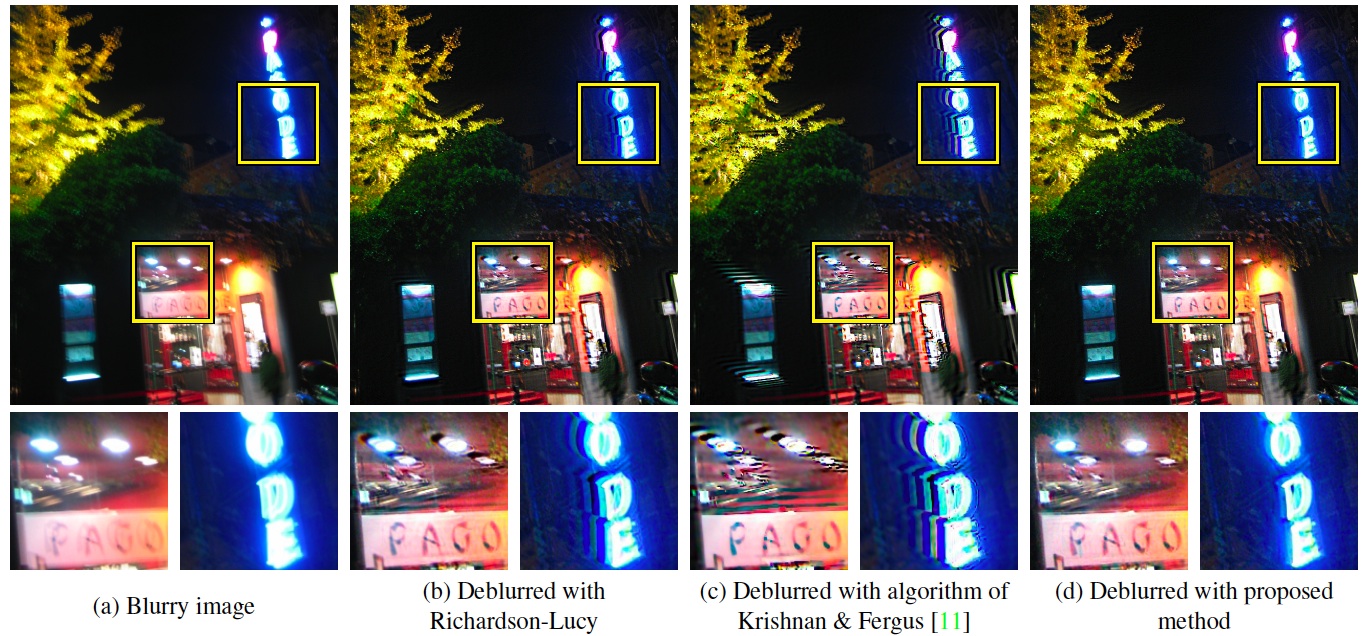Section: New Results
Image restoration, manipulation and enhancement
Non-uniform Deblurring for Shaken Images
Participants : Oliver Whyte, Josef Sivic, Andrew Zisserman, Jean Ponce.
We argue that blur resulting from camera shake is mostly due to the 3D rotation of the camera, causing a blur that can be significantly non-uniform across the image. How- ever, most current deblurring methods model the observed image as a convolution of a sharp image with a uniform blur kernel. We propose a new parametrized geometric model of the blurring process in terms of the rotational velocity of the camera during exposure. We apply this model in the context of two different algorithms for camera shake removal: the first uses a single blurry image (blind deblurring), while the second uses both a blurry image and a sharp but noisy im- age of the same scene. We show that our approach makes it possible to model and remove a wider class of blurs than previous approaches, and demonstrate its effectiveness with experiments on real images.
The project resulted in a publication [5] .
Deblurring shaken and partially saturated images
Participants : Oliver Whyte, Josef Sivic, Andrew Zisserman.
We address the problem of deblurring images degraded by camera shake blur and saturated or over-exposed pixels. Saturated pixels are a problem for existing non-blind deblurring algorithms because they violate the assumption that the image formation process is linear, and often cause significant artifacts in deblurred outputs. We propose a forward model that includes sensor saturation, and use it to derive a deblurring algorithm properly treating saturated pixels. By using this forward model and reasoning about the causes of artifacts in the deblurred results, we obtain significantly better results than existing deblurring algorithms. Further we propose an efficient approximation of the forward model leading to a significant speed-up. Example result is shown in figure 4 .
The project resulted in a publication [19] .
|
Dictionary Learning for Deblurring and Digital Zoom
Participants : Florent Couzinie, Julien Mairal, Jean Ponce, Francis Bach [INRIA SIERRA] .
This work proposes a novel approach to image deblurring and digital zooming using sparse local models of image appearance. These models, where small image patches are represented as linear combinations of a few elements drawn from some large set (dictionary) of candidates, have proven well adapted to several image restoration tasks. A key to their success has been to learn dictionaries adapted to the reconstruction of small image patches. In contrast, recent works have proposed instead to learn dictionaries which are not only adapted to data reconstruction, but also tuned for a specific task. We introduce here such an approach to deblurring and digital zoom, using pairs of blurry/sharp (or low-/high-resolution) images for training, as well as an e?ective stochastic gradient algorithm for solving the corresponding optimization task. Although this learning problem is not convex, once the dictionaries have been learned, the sharp/high-resolution image can be recovered via convex optimization at test time. Experiments with synthetic and real data demonstrate the e?ectiveness of the proposed approach, leading to stateof-the-art performance for non-blind image deblurring and digital zoom.
This work has resulted in a publication [1] .
Sparse Image Representation with Epitomes
Participants : Louise Benoit, Julien Mairal, Jean Ponce, Francis Bach [INRIA SIERRA] .
Sparse coding, which is the decomposition of a vector using only a few basis elements, is widely used in machine learning and image processing. The basis set, also called dictionary, is learned to adapt to specific data. This approach has proven to be very effective in many image processing tasks. Traditionally, the dictionary is an unstructured "flat" set of atoms. In this work, we study structured dictionaries which are obtained from an epitome, or a set of epitomes. The epitome is itself a small image, and the atoms are all the patches of a chosen size inside this image. This considerably reduces the number of parameters to learn and provides sparse image decompositions with shift invariance properties. We propose a new formulation and an algorithm for learning the structured dictionaries associated with epitomes, and illustrate their use in image denoising tasks.
This work has resulted in a CVPR'11 publication [6] .
Proximal Methods for Hierarchical Sparse Coding
Participants : Julien Mairal, Rodolphe Jenatton [INRIA SIERRA] , Guillaume Obozinski [INRIA SIERRA] , Francis Bach [INRIA SIERRA] .
Sparse coding consists in representing signals as sparse linear combinations of atoms selected from a dictionary. We consider an extension of this framework where the atoms are further assumed to be embedded in a tree. This is achieved using a recently introduced tree-structured sparse regularization norm, which has proven useful in several applications. This norm leads to regularized problems that are difficult to optimize, and in this paper, we propose efficient algorithms for solving them. More precisely, we show that the proximal operator associated with this norm is computable exactly via a dual approach that can be viewed as the composition of elementary proximal operators. Our procedure has a complexity linear, or close to linear, in the number of atoms, and allows the use of accelerated gradient techniques to solve the tree-structured sparse approximation problem at the same computational cost as traditional ones using the l1-norm. Our method is efficient and scales gracefully to millions of variables, which we illustrate in two types of applications: first, we consider fixed hierarchical dictionaries of wavelets to denoise natural images. Then, we apply our optimization tools in the context of dictionary learning, where learned dictionary elements naturally self-organize in a prespecified arborescent structure, leading to better performance in reconstruction of natural image patches. When applied to text documents, our method learns hierarchies of topics, thus providing a competitive alternative to probabilistic topic models.
This work has resulted in a publication [3] .



